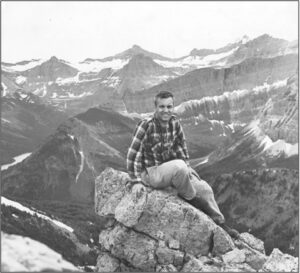
Those closest to him say Dale Burk, who grew up in a logging family, “had his boots in Montana mud and his hands on Tobacco Valley lumber.” When family sawyers instinctively know how to use a two-person saw to fell a tree in thick stands of dark timber, you learn to pay attention. You take mental notes. You remember things. All these mental traits paid off for Burk, Montana, and the nation.
For 10 years, Burk worked at the Missoulian, Missoula’s daily newspaper. His dogged pursuit of a story saw him progress from reporter to columnist, to editor, to editorial-page writer. In 1968, his first year at the paper, Burk drifted toward familiar stories and soon contacted Guy Brandborg, a forester on the Bitterroot National Forest. Both once lived in small communities where logging was a primary economic force. Together they compared mental notes and remembered things, especially the families still working in the woods and timber mills.
Their talks set Burk on a reportorial course in 1969 that resulted in a series of articles about Forest Service clearcutting. His reporting brought national attention to misguided, unsustainable, and economically irrational activities. Burk uncovered massive clearcutting, aggressive road-building, terracing, and logging-centric management that gave short shrift to the concept of multiple-use.
His groundbreaking reporting continued for several years. In 1971, The New York Times published a Burk photograph of Brandborg and a Wyoming senator viewing a clearcut that resembled a carpet-bombed landscape. It enraged the nation.
Few environmental reporters existed then, much less investigative reporting by Montana media. Burk broke new ground to inform Montanans about forest management—catalyzing crucial national support for reforms. Harvard took notice and awarded Burk with its 1975-76 Nieman Fellowship for journalism.
Burk’s work was indeed controversial but stood the test of time. His work helped spark passage of the National Forest Management Act while he displayed professional courage, and weathered aggressive criticism, to ensure Montanans, Americans, and the Congress learned the truth to provide a better future for our forests.
His newspaper work also launched a long career as a conservation advocate via his publishing house, Stoneydale Press. For example, his book, Great Bear, Wild River, was instrumental in the 1978 designation of the Great Bear Wilderness along the Middle Fork of the Flathead River.
Numerous accolades came Burk’s way, but it’s perhaps most fitting that his local club, the Ravalli County Fish & Wildlife Association, awarded him with its Lifetime Achievement Award, and that the Missoula Conservation Community names its annual award for most outstanding citizen advocate after Burk.
Dale Burk’s lifelong contribution as a conservation leader shaped our outdoor heritage. Burk and his work serve as reminders that journalists and a free press are vital to a civil society.
By Tom Palmer, Montana Outdoor Hall of Fame
The Missoula Conservation Roundtable gratefully acknowledges generous contributions to our website design. Our logo was created by Kate Davis, Raptors of the Rockies; Brian Christianson contributed the photographs for page headers Brian Christianson Photography
Website created by Irestone Web Design
